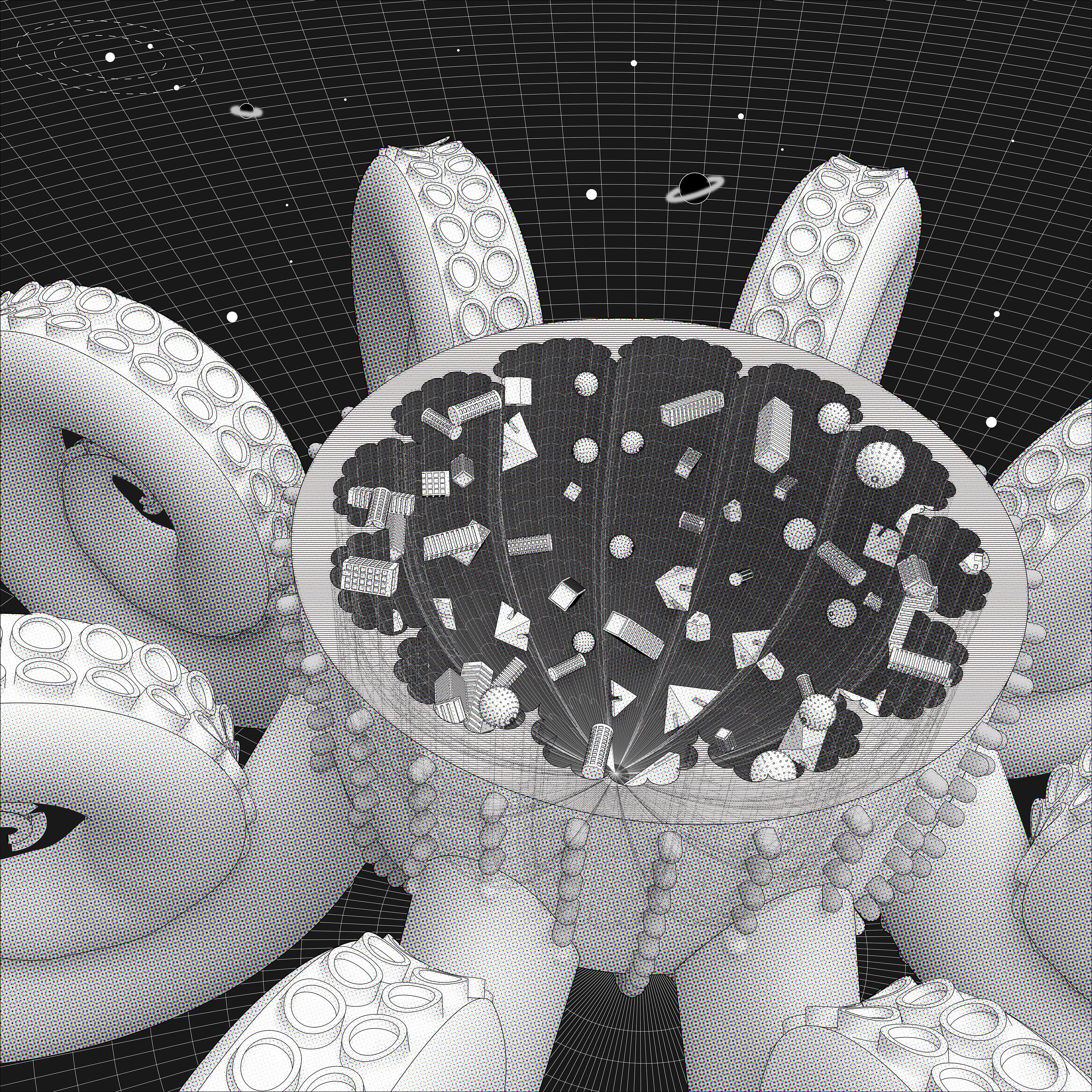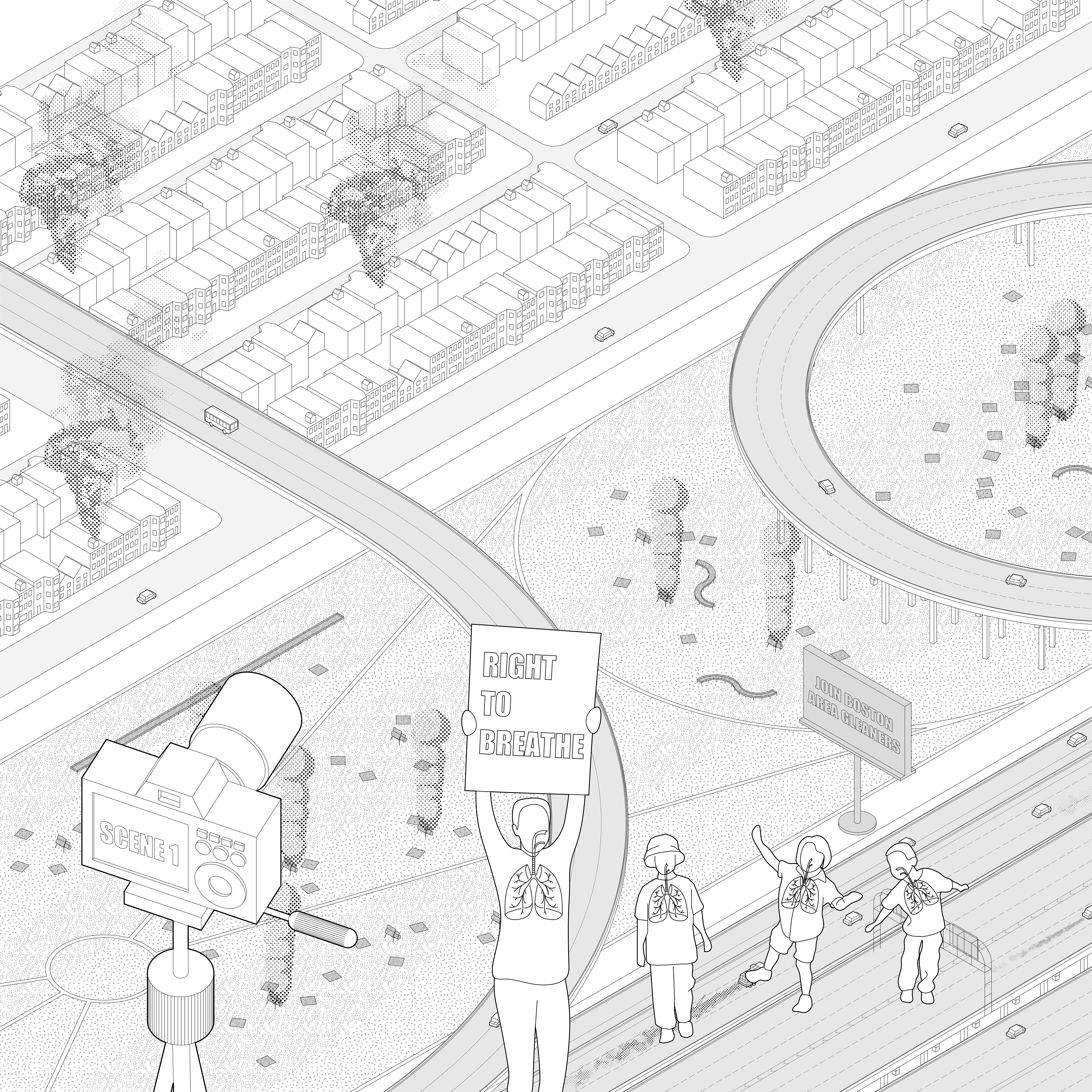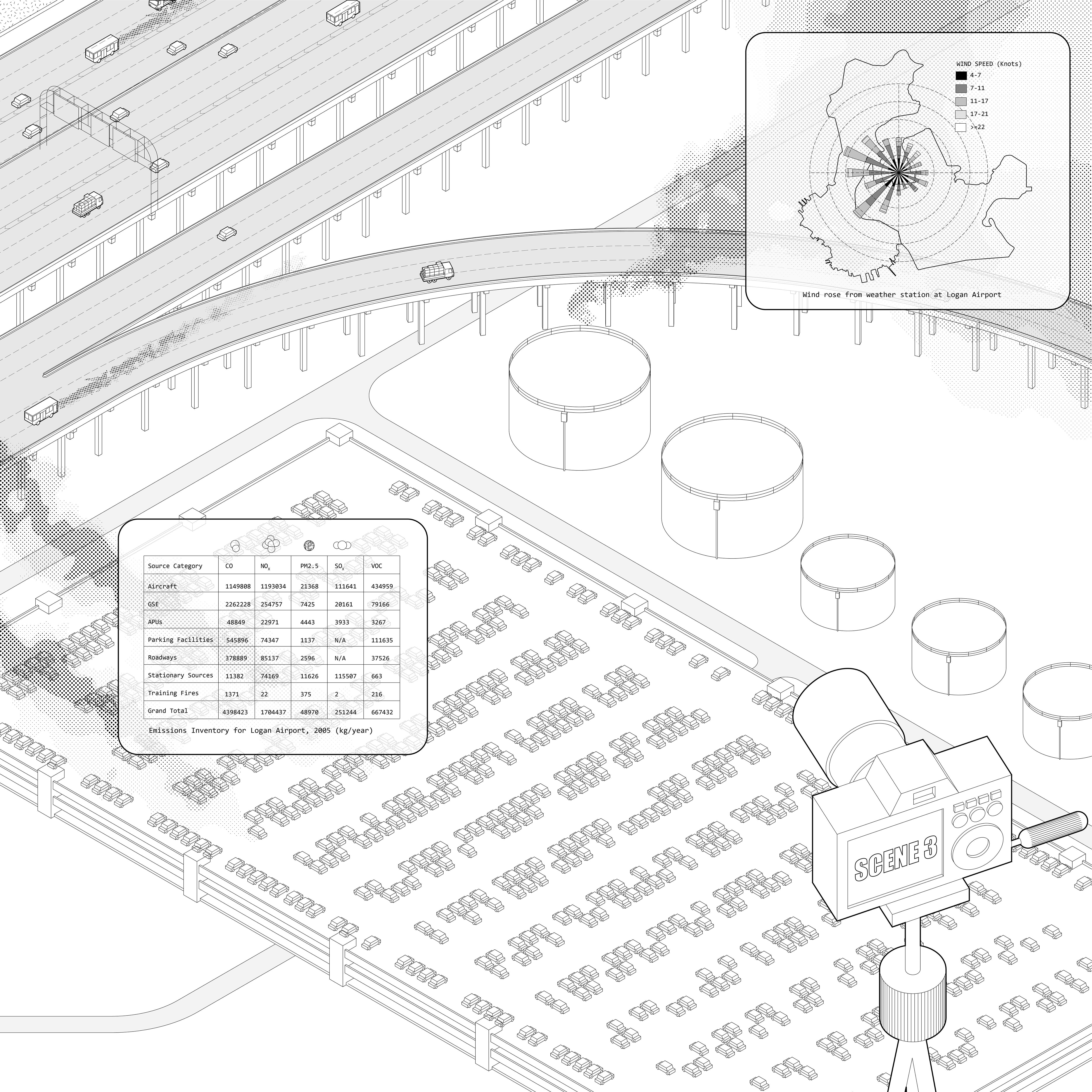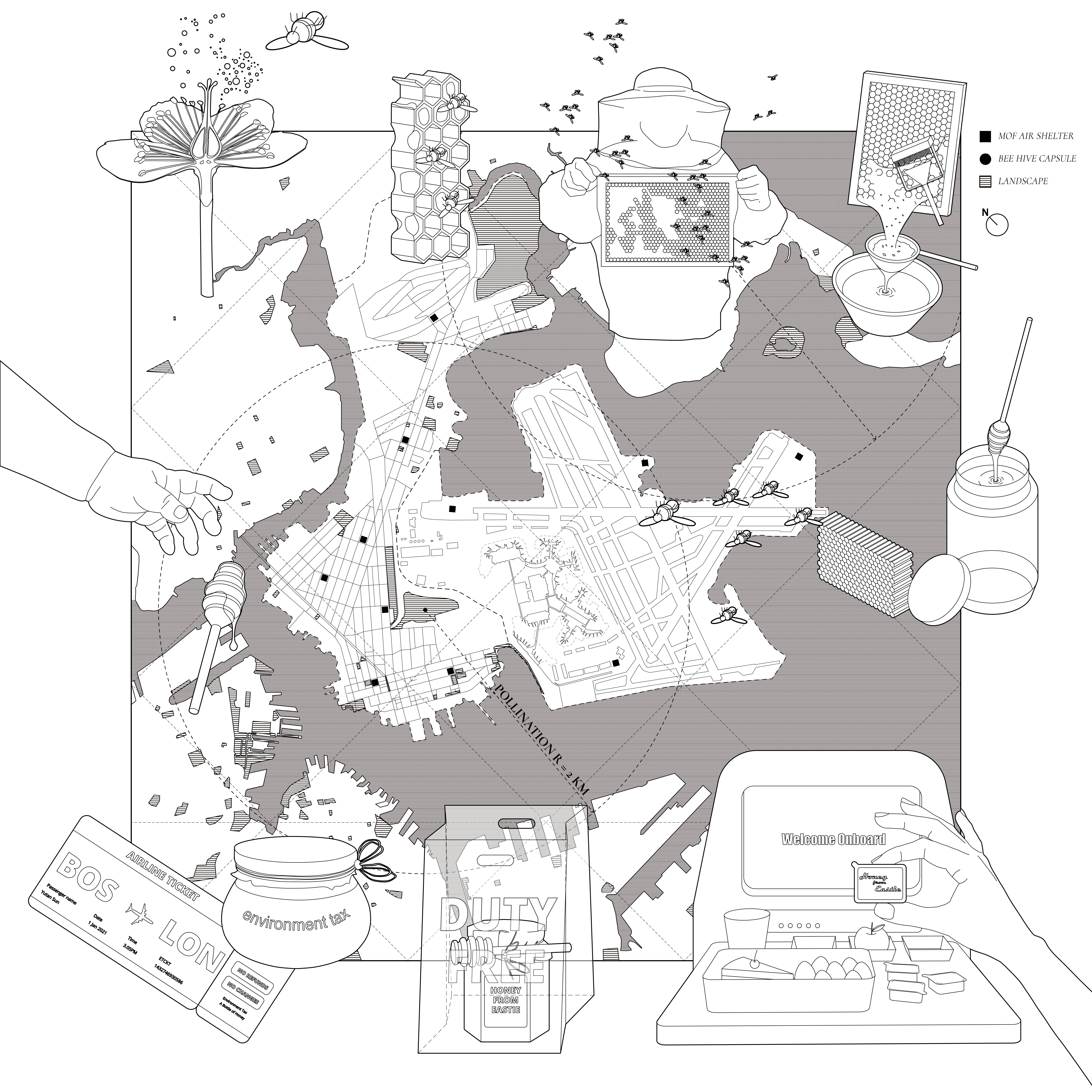















Food Landscape in East Boston - Right to the Air
2020 Fall MIT Option Studio
Site: East Boston, MA
Date of Project: December 2020
Instructor: Rania Ghosn
The project “the right to the air” begins with redefining our conception of the atmosphere -- the air that we collectively breathe and inhabit. The atmosphere is not understood as a neutral zone, but as a set of ambient conditions and spatial localities that are bound in an inescapable coexistence with their surrounding landscapes. The conditions of the atmosphere are intertwined in the politics, economics, and ecologies of it’s embedded spaces and territories, globally and locally. And with the rising threat of climate catastrophe, the once ambiguous and invisible issues of the atmosphere have begun to take center stage in climate politics.
This project positions the atmosphere as the central matter of concern, understanding the air as a key actor and stakeholder in politics traversing a multitude of scales -- from the individual to the community to the planetary.
In representing this multiplicity, Bruno Latour, in his book Facing Gaia, urges us away from our traditional modes of representing the Earth from the outside-in -- such as in the iconic Blue Marble -- and instead advocates for a reading of the planet from the inside-out, which he calls the critical zone -- or the thin layer of Earth that we inhabit, alongside all other human and non-human forms of life and agencies. The critical zone calls for a new form of Earthly politics that recognizes the multiplicities of agents that occupy the planet. A politics that is “no longer about humans making decisions on their own and for themselves only, but one where new forms of citizenship and new types of attention and care for life forms are required to generate a common ground.”
At the planetary scale, the continuous growth of greenhouse gases and harmful pollutants into the atmosphere via industrialization, has become a pressing concern. The understanding of the pollution at this scale comes with a mixture of the feeling of individual and collective responsibilities, with various activities and industries becoming tagged with their associated “carbon footprints” while also allowing these metrics to fade into a catastrophic global image. These new metrics of responsibility in regards to the atmosphere are representative of a need to feel some agency in both our singular and collective roles in climate change. We must ask who is responsible and who is most deeply affected.
Flying has therefore become a highly controversial topic in climate politics, with the aviation industry currently making up about 2% of the total planetary greenhouse emissions and growing at an increasing pace of 4.3% per year, with a revenue of around 612 billion dollars. Flying is associated with high emissions of harmful greenhouse gases. Unlike other industries, air travel is more directly associated with individual behavior - travelers are rewarded with frequent flyer miles and with each flight we can find a direct correlation to a carbon footprint. While the emissions are negatively affecting all of the world population, only 20% flies regularly. Who is paying the price?
The growing pushback on the emissions of the aviation industry has led to some government intervention, such as through the implementation of carbon taxing, and the growing stigma has caused many airports to implement sustainability plans to appease concerned fliers, and avoid penalization. However, these concerns generally only address the global impacts of the airline industry. At the local scale additional concerns are mounted by the airport’s direct neighbors. We will zoom in on Boston Logan Airport.
Zooming into the site in East Boston, we can see the local impacts of the aviation industry through the relations between the Boston Logan airport and its surrounding communities. In terms of land, Logan occupies over 50% of the peninsula of East Boston. Owned by the Massachusetts Port Authority, or Massport, this land is the site of economic, industrial, and infrastructural activity; but it is nearly empty of cultural and ecological activity. As the historic site of massive land reclamation projects, Logan maintains a strict control over the ecologies within and near its borders. For security and safety reasons, wildlife and insects are strictly limited on airport property. The enforcement of this includes a set of preventive measures, including the extremely controlled landscaping of the airport ground to prevent the attraction of wildlife.
Simultaneously, the Logan airport is, and has historically been, the contentious center of environmental and health concerns for the surrounding East Boston community. Although the activities of the airport and the residents of East Boston are split by urban infrastructures (such as highways, industry, and green space), proximity and a shared atmosphere binds them together. In addition to greenhouse gas emissions, which contribute to climate change, the planes also emit ultrafine particulate matter.
Ultrafine particles are scattered locally upon the takeoff and landing of flights, reaching the ground in high concentrations when at an elevation below 350 meters. Breathing in these invisible particulates in the air can be harmful, and the presence of these emissions has become increasingly concerning to the local community. Health studies have shown that this particulate matter can be correlated to high instances of asthma in children and COPD in adults in East Boston. A number of community organizations and activist groups in East Boston, which include Mothers out front, AIR INC. and the East Boston neighborhood health center, work to bring awareness and find solutions to these concerns.
Similar to many other airports globally, Logan has put forth a set of sustainability goals to reduce greenhouse gas emissions and increase climate resiliency. Many of these goals are insular to the airport’s land (LEED/climate-proofing) or only address carbon and not particulate emissions.
Looking quickly at the economic dynamics on the East Boston peninsula. Economically, Logan brings in about 106 million in revenue, with several of its largest income sources also being the largest sources of carbon and ultrafine particle emissions. Logan also doesn’t pay taxes. All of the airport’s land is non-taxable, so although the residents of East Boston pay the price for harmful activities of the airport that created this 106 mill revenue, Logan pays very little of this back to the community. The economic disparities that occur near Logan’s boundaries becomes visible here, with the residents with the lowest average incomes living closest to the airports and its surrounding highway networks.
There is a history of protest movements in East Boston due to the insufficient response by Logan on it’s roles in environmental disparities in the neighborhood, and increased worries about adverse health effects on the community. Since the 1960s the mothers of East Boston have been protesting on the streets and doing advocacy work through community organization on behalf of the health of their community. Today this effort exists through the East Boston chapter of Mothers Out Front. Their work centers on the prevalence of asthma among children. Their current campaigns are urging Massport to provide HEPA filters to all schools, public spaces, and residents of East Boston, in order to mitigate the adverse health effects of the ultrafine particles constantly being emitted by the planes flying overhead. They also advocate for the planting of trees around the neighborhood, calling them “nature’s filters.”
Through a series of spatial strategies, this project stand with the concerns of Mothers Out Front, and the lineage of bottom-up, community-led protest movements in East Boston, which have been successful in providing filters, reclaiming lost land, and publishing health studies.
However, this project also seek to acknowledge the scalar discrepancies between the community’s advocacy work and Massport’s activities. We would like to imagine what a scaled up response to the issues of air pollution would look like for the East Boston community, traversing scales from the individual HEPA filter to urban infrastructures.